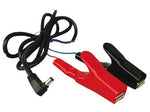You have no items in your shopping cart.
Electric Fencing for Chickens
Electric Fencing is highly suitable to use with Chickens
The availability of electric fencing has transformed free-range poultry keeping. It is arguable that without it, the keeping of extensive, free-range commercial poultry flocks would never have happened.
Electric fencing for chickens is extremely portable and versatile; it may be used on its own for both permanent and temporary fencing and has been used around the world to control every predator in some guise or other. Fortunately foxes are easily controlled and do not burrow under an efficient Electric chicken netting nor jump over it. Chickens however, are well insulated by their feathers and a range of hotShock energisers have been developed to counter this problem. They run at a higher voltage than standard energizers so are able to bridge the gap caused by feathers and are very effective at controlling both poultry and foxes. It is cheaper, easier to erect, more effective and far safer than barbed wire and is a fraction of the cost of a fox-proof wire mesh fence. Permanent boundary fence lines should be constructed from solid wire on insulated poles spaced at intervals suitable for foxes.
Lightweight electric netting is available, that can be dismantled, bundled up and re-erected further on. It is effective at allowing poultry access to specific grazing areas, as well as excluding a fox. This then allows areas of grass to re-generate and be re-rejuvenated ready for using again. The netting is made of polythene and stainless steel conducting twine and is erected with support poles and ground spikes. The bottom line in contact with the ground is not be energised to prevent leakage of the Electric current. If a good fence is installed and a few criteria are adhered to, the maintenance on an electric fence may be LESS than other fences. When taking a net down, do not try and roll it up, this causes a mess. Simply gather the posts together allowing the nets to fold against themselves.

An adequately designed and constructed electric fence works by the combination of a weak physical barrier (the fence) and a strong psychological imprint (the 6000v sting) created in the mind of the animal. An energiser attached to the fence wires produces a short but painful sting when touched by the animal, similar to a sharp slap. The low amperage (15-100mA) and short duration (about 1/300th. of a second) results in a sharp but safe sting that then creates a psychological barrier that the animal associates with the fence and discourages it from touching again.
A "wimpy" fence energiser WILL give you a wimpy electric fence. Foxes and chickens will think a fence is a joke without a strong bite and they'll walk right through it. Please invest in one that puts out lots of power. During a wet year, you may have lots of plant growth touching the wires. That's when you will need extra oomph to power through the casual vegetation and assist in maintaining a good fence, but this should not be counted on to maintain your fence. Electric netting is very resource hungry in itself so more powerful 12v or mains energisers are required. A 9v energiser will only run 1 net at best.
A rusty piece of metal buried a few inches underground is not an adequate earth post. Rust is not a good conductor and the long-term chemical reactions between the soil and metal result in the majority of problems. 12v systems and above require an earth post at least 1m long driven into wet soil to be totally efficient. The more soil/metal contact that can be achieved, the better.
- Electric Netting
- Tape, Twine, Wire And Rope
- Fencing Energisers
- Fencing Posts
- Insulators
- Accessories
- Electric Fencing Kits
- Chicken Feeders and Drinkers
-
Information
- What is Electric Fencing
- Advantages of an Electric Fence
- Installing a Fence
- Is an Electric Fence a serious risk
- How to Erect a Net
- What you Need for a Fence
- Testing an Electric Fence
- Quantities Guide
- Improve Your Fence
- Poultry Netting Trial
- Electric Netting Dimensions
- Electric Fencing Mistakes
- TLD Max Technology
- Energiser Terminology
- Choosing an Energiser
- Fencing Articles
- Trouble Shooting
- Delivery Terms
- Frequently Asked Questions
- Here's a Blog Worth Reading
- Price
-
-
Below $100.00
-
$100.00-199.00
-
$200.00-299.00
-
$300.00-399.00
-
$400.00-499.00
-
Above $500.00
-
- Color
-
-
- Size
-
-
S
-
M
-
L
-
XL
-
2XL
-
3XL
-
- Brand
-
-
Adidas
-
Camel
-
Motorola
-
Rolex
-
Samsung Galaxy
-
Seiko
-
Sony
-








